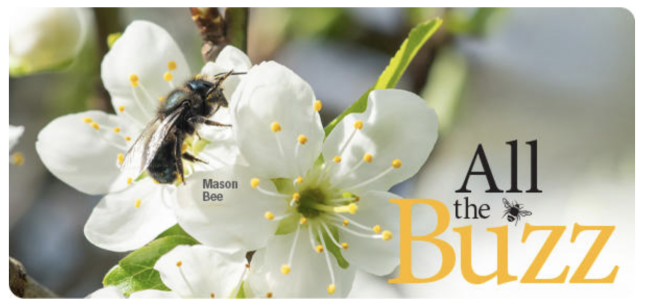
Mason bees are all the buzz as an incredibly effective, native pollinator and are among the easiest bees to raise in your yard, while also being the safest due to their gentle nature.
Few strategies for keeping our environment healthy are as interesting, simple and fun as raising mason bees, tiny insects that are gaining popularity with gardeners and farmers alike. What’s more, encouraging wild mason bees to your slice of earth – no matter how small or urban – could help counter negative effects of declining honey bee colonies. Some experts even believe that continuing to build up wild bee populations, and managing them to work more extensively as orchard or field pollinators, could be an important step in ensuring that some of our most nutritious foods, like almonds, melons, and blueberries, continue to be readily available, high in quality, and affordable.
So, what is a mason bee? And how is it different than the European honey bee, known and loved by all for putting honey on our biscuits? For starters, mason bees don’t make honey. But they do pack a punch with their pollination skills, making it possible for plants to set seed and reproduce, for fruit trees and berry canes to increase their yield, and for flower landscapes to burst with color. They are extraordinary pollinators – just 250-300 females can pollinate an entire acre of apples or cherries – and are often touted as being more efficient than honey bees. Of the roughly 150 mason bee types in North America, most are native. Also, many types of mason bees occur naturally over wide geographic regions, so it’s possible you have some flitting about your backyard already. With a few supplies and some knowledge in hand, you could easily start propagating your own population of these native pollinators.
Unlike honey bees, mason bees carry pollen on their bellies rather than on their hind legs, which helps to make them highly efficient pollinators. A single mason bee will visit between 1,600 to 2,400 blossoms daily, and pollinate over 90% of them. A female visits an average of 75 flowers per foraging trip. Mason bees lay their eggs in tunnel nests that are constructed in abandoned holes created by wood-boring insects, hollow plant stems or artificial houses and tubes. Although mason bees are solitary, they are often gregarious and will nest near other mason bees. When building their nests, female mason bees use clay to build partitions and to seal the tunnel entrance. This unique mud-building behavior is what led to the name “mason” bee.
Mason bees are not aggressive towards people. You can watch them work without fear of being stung. Mason bees are metallic blue, black or green in color and about the same size as a house fly. There are 140 species of mason bees in North America.
Visit our store to learn what you can do to cultivate pollinators in your yard.
Below are 2 up-close views of Mason Bees in Mason Bee houses.

Pollinators: Monarchs and Mason Bees
This episode is all about pollinators. John and Brian are discussing monarch butterflies and mason bees. These critters are so important to your backyard; they don’t just help your plants, but the birds as well. What’s bugging you? We hope it’s not the pollinators!
Click here to listen to the episode.






